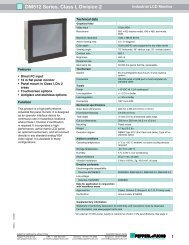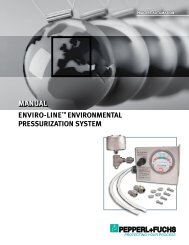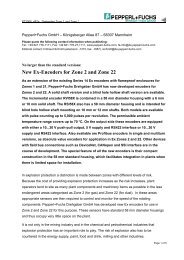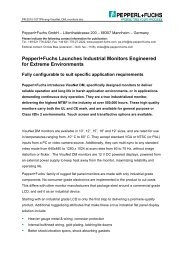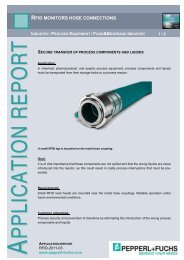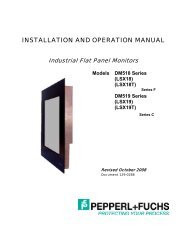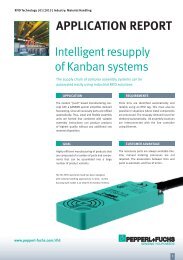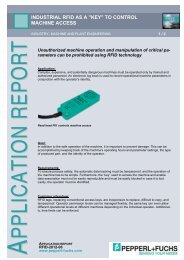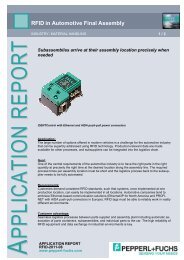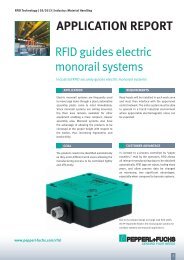Download Now - Pepperl+Fuchs
Download Now - Pepperl+Fuchs
Download Now - Pepperl+Fuchs
You also want an ePaper? Increase the reach of your titles
YUMPU automatically turns print PDFs into web optimized ePapers that Google loves.
PR-2010-1156PA-eng-Separator Alarm Systems<br />
<strong>Pepperl+Fuchs</strong> GmbH – Lilienthalstrasse 200 – 68307 Mannheim – Germany<br />
Please indicate the following contact information for publication:<br />
Tel.: +49 621 776-2222, Fax: +49 621 776-27-2222, www.pepperl-fuchs.com, pa-info@de.pepperl-fuchs.com<br />
Editorial contact: Christa Blas (extension: -1420, fax: -1108), cblas@de.pepperl-fuchs.com<br />
Be Warned!<br />
Separator Alarm Systems from <strong>Pepperl+Fuchs</strong><br />
For commercial facilities such as auto workshops, filling stations or car washes,<br />
which handle oil or gasoline or clean oil-contaminated parts, the installation of light<br />
liquid separator systems is required by law. Moreover, in order to guarantee long-term<br />
error-free operation, the systems must be continuously checked and maintained, and<br />
a general inspection undertaken every five years. This is regulated in detail by the<br />
technical standards for oil separators. These measures provide the ideal conditions<br />
for soil and ground water protection, however, the reality is often very different.<br />
Sludge traps are not always emptied regularly or oil layers above a permitted<br />
thickness disposed of incorrectly. This is often simply because no one notices that<br />
the systems buried in the ground have long been overflowing. In order to counteract<br />
this danger, Mannheim-based company <strong>Pepperl+Fuchs</strong> has developed alarm systems<br />
for light liquid separator systems that report loudly and clearly when a critical level is<br />
reached. The various device types and their features were presented at the IFAT<br />
ENTSORGA 2010 trade fair in Munich.<br />
The principle of the light liquid separator system is simple enough: because oil and gasoline<br />
are lighter than water, they float up and collect on the water’s surface, where they can easily<br />
be siphoned off and disposed of. In filling stations or car washes, such systems should<br />
prevent fuel and lubricants leaking uncontrolled and polluting the environment.<br />
“If, during refueling, a few drops fall from the nozzle or the tank overflows, it mustn’t simply<br />
be washed into the sewer system next time it rains,” explains Michael Göltz, Key Account<br />
Manager at <strong>Pepperl+Fuchs</strong> in Mannheim. “In facilities where oil or gasoline is handled, the<br />
installation of light liquid separator systems is required by law.” However, installation alone is<br />
not enough. To guarantee long-term error-free operation, the systems must be checked<br />
monthly, maintained every six months and a specialist general inspection undertaken every<br />
five years. In the event of deficiencies, the operator is officially required to eliminate them.
This is regulated in detail by the technical standards for oil separators DIN 1999-100, EN<br />
858-1 and EN 858-2.<br />
The regulations, however, do not present the whole picture. “In this country, however,<br />
implementation is handled in very different ways in practice,” admits Göltz. “In some of the<br />
Länder in Germany, there is particularly strict control, while in other areas, the responsibility<br />
is virtually left to the operators alone.” From many years of experience, the expert is aware of<br />
many problems: some facility operators were simply overwhelmed with the technology,<br />
perhaps not even noticing that oil was continuously seeping into the ground as a result of<br />
leaking manhole covers and overfilled containers, . “In one case, a system had been installed<br />
decades before, but was never operated correctly. The transportation lock was still attached.<br />
This kind of thing can go unnoticed for quite a while. When the environmental damage is<br />
discovered, the operator is immediately presented with the bill.”<br />
Oversight is no protection from liability, however. Even if the environment agencies are more<br />
casual in some places, the operators of separators should nevertheless err on the side of<br />
caution. For Michael Göltz, reliable and comprehensive monitoring of the functionality of light<br />
liquid separator systems is ultimately only possible with the aid of electronic alarm systems.<br />
Critical operating conditions must be automatically detected and reported. “You can’t wait<br />
until an untrained employee may notice something at some point. In an urgent case, an<br />
alarm must be triggered automatically, and action taken immediately.”<br />
Although the standard fundamentally stipulates alarm systems for the installation of a new<br />
separator, local authorities may permit the use of separator systems without automatic alarm<br />
units. And according to conservative estimates, there are approximately 400,000 examples<br />
of old stock in Germany alone. This is a ticking bomb for the environment, however, the<br />
problem has not yet reached public awareness. In fact, neither decontamination of the<br />
containers, nor the installation of alarm systems is particularly expensive.<br />
In order to ensure appropriate monitoring, the <strong>Pepperl+Fuchs</strong> alarm systems for light liquid<br />
separator systems can be combined with a variety of sensors. All sensors have ATEX<br />
approval and are approved for installation in Zone 0. The compact and robust design has no<br />
moving parts. The sensor can be optimally positioned, hanging from the pre-installed five<br />
meter cable, in the separator. “An alarm system consists of a control unit (usually installed in<br />
the building or in a small control cabinet) and various sensors, combined in accordance with<br />
the application,” explains Henrik Villumsen, SAS Product Manager at <strong>Pepperl+Fuchs</strong>. “A<br />
sensor for measurement of the oil layer, a fluid sensor and, if there is a sludge trap, a sludge<br />
level sensor.”<br />
• The oil layer sensor monitors the thickness of an oil layer. It is able to distinguish<br />
between water and oil or gasoline as well as between water and air. If the layer thickness<br />
PR-2010-1156PA-eng-Separator_ Alarm_Systems.doc Page 2 of 7
exceeds a particular maximum level, a signal is triggered, which is evaluated by the<br />
control unit, and an alarm is triggered. This can prevent oil from overflowing and<br />
penetrating into the waste water.<br />
• A fluid sensor can differentiate between gaseous and liquid media, and therefore<br />
between air and waste water. The sensor sends an alarm signal to the control unit as<br />
soon as the fluid level has exceeded a particular maximum level. For example, the fluid<br />
sensor can detect when a coalescence filter is contaminated, helping to prevent<br />
overflowing.<br />
• The sludge level sensor differentiates between sludge and fluid and monitors the<br />
sludge level in the sludge trap or directly in the light liquid separator system. If the<br />
maximum level is reached, the sensor triggers a signal which is evaluated by the control<br />
unit, and an alarm is activated. This permits prompt detection in the event that the light<br />
liquid separator system has been obstructed with sludge.<br />
Whether you’re monitoring a single separator at a village filling station or a large-scale<br />
separator system at an international airport, the principle is always the same, and the same<br />
devices can be installed for large applications as well as small ones. “We always deliver the<br />
complete package,” assures Key Account Manager Göltz, “from the control unit, probes, and<br />
housing right down to the suspension braces, everything is included.”<br />
“Normally, the systems are adjusted so that they trigger an alarm at 80 percent of the<br />
maximum storage capacity. This leaves enough time to take the required action,” says<br />
Henrik Villumsen, adding that, “The alarm can be audible with a buzzer, visual with LEDs, or<br />
sent as a text message to a cell phone via an built-in GSM modem. It is not defined in<br />
standard EN 858-1 how the appropriate persons should be warned. The main thing is that<br />
they are informed and without delay.”<br />
An alarm by cell phone is becoming increasingly important particularly at filling stations, as<br />
the product manager explains: “In more and more filling stations, there are no qualified<br />
personnel on site anymore. Students or homemakers stand at the checkout. It is quite<br />
obvious that an alarm is of little use to this type of staff.” A text message to the operator or<br />
service firm responsible can save a lot of time in case of an emergency and during an<br />
unpreventable event like a cloudburst, prevent considerable damage to the environment.<br />
Certainly, the prerequisite is that the sensors are correctly installed and configured. For this<br />
purpose, <strong>Pepperl+Fuchs</strong> hosts detailed product training courses as well as information<br />
events for end customers. “The alarm system of a regularly maintained oil separator may<br />
never trigger an alarm,” admits Henrik Villumsen. “But if it does, haste is required: then<br />
everyone needs to know what to do."<br />
PR-2010-1156PA-eng-Separator_ Alarm_Systems.doc Page 3 of 7
Facts and figures about <strong>Pepperl+Fuchs</strong><br />
<strong>Pepperl+Fuchs</strong> was founded in 1945 by Walter Pepperl and Ludwig Fuchs as a radio repair<br />
workshop. In 1948, <strong>Pepperl+Fuchs</strong> expanded its activities to the production of electronic<br />
components, which in 1958, led to the development of the first proximity sensor and the first<br />
transistor amplifier with an intrinsically safe circuit. Since then, <strong>Pepperl+Fuchs</strong> has developed<br />
into a diversified industrial enterprise and employs 3,700 workers at over 80 locations on six<br />
continents and has production facilities in Germany, the USA, Singapore, Hungary,<br />
Indonesia, Vietnam, China, and India, the majority of which are certified in accordance with<br />
ISO 9001. At <strong>Pepperl+Fuchs</strong>, the production of alarm systems for light liquid separator<br />
systems began with the purchase of the Mannheim company Ruf, which had supplied<br />
systems of this type since 1975.<br />
About <strong>Pepperl+Fuchs</strong><br />
<strong>Pepperl+Fuchs</strong> is a leading developer and manufacturer of electronic sensors and<br />
components for the global automation market. For more than 60 years, our continuous<br />
innovation, high quality products, and steady growth has guaranteed us continued success.<br />
One Company – Two Divisions<br />
<strong>Pepperl+Fuchs</strong> – PROTECTING YOUR PROCESS<br />
The Process Automation Division is a market leader in intrinsically safe explosion<br />
protection. We offer comprehensive, application-oriented system solutions, including<br />
customer-specific control cabinet solutions for the process industry. A large portfolio of<br />
components is available from our various product lines: isolated barriers, fieldbus<br />
infrastructure solutions, remote I/O systems, HART interface solutions, level measurement<br />
devices, purge and pressurization systems, industrial monitors and HMI solutions, power<br />
supplies, separator alarm systems for oil and petrol separators, signaling equipment, lighting<br />
as well as emergency shutdown equipment and accessories.<br />
<strong>Pepperl+Fuchs</strong> – SENSING YOUR NEEDS<br />
With the invention of the inductive proximity sensor in 1958, the company set an important<br />
milestone in the development of automation technology. Under the motto “Sensing your<br />
needs”, customers benefit from tailor-made sensor solutions for factory automation. The<br />
main target markets of the factory automation are machine and plant construction, the<br />
PR-2010-1156PA-eng-Separator_ Alarm_Systems.doc Page 4 of 7
automotive industry, storage and material handling, printing and paper industry, packaging<br />
technology, process equipment, door, gate and elevator construction, mobile equipment,<br />
renewable energies.<br />
The division offers a wide product range of industrial sensors whether it’s inductive,<br />
photoelectric or ultrasonic sensors, rotary encoders, identification systems, barcodes, code<br />
readers for data-matrix-codes and vision sensors.<br />
Key words:<br />
Separator Alarm Systems, light liquid separator system, oil<br />
separator, EN 858-1, EN 858-2, DIN 1999-100, oil layer sensor,<br />
fluid sensor, sludge level sensor<br />
Author:<br />
Michael Göltz<br />
Key Account Manager Separator Alarm Systems<br />
Division Process Automation<br />
Henrik Villumsen<br />
Product Manager Separator Alarm Systems<br />
Division Process Automation<br />
Characters:<br />
Characters short text:<br />
Pictures:<br />
6,794, without space characters<br />
1,001, without space characters<br />
No. MC7522_080801_02, No. MC4676_071218_01,<br />
No. MC7522_100811_03, No. MC7522_100811_02,<br />
No. MC7522_100811_01, No. MC7522_100813_01,<br />
No. MC7522_080425_02<br />
August 2010<br />
PR-2010-1156PA-eng-Separator_ Alarm_Systems.doc Page 5 of 7
Fig. 1: <strong>Pepperl+Fuchs</strong> Headquarters in Mannheim<br />
Fig. 2: In filling stations or car wash installations, such systems are aimed at preventing fuel and<br />
lubricants leaking uncontrolled and polluting the environment.<br />
Fig. 3: Michael Göltz, Key Account Manager at <strong>Pepperl+Fuchs</strong> in Mannheim.<br />
PR-2010-1156PA-eng-Separator_ Alarm_Systems.doc Page 6 of 7
Fig. 4: Henrik Villumsen, SAS Product Manager at <strong>Pepperl+Fuchs</strong><br />
Fig. 5: The sensor can be optimally positioned in the separator, on its pre-fitted five meter cable.<br />
Fig. 6: Sludge level sensor in a set with control unit, wall box, cable connectors and suspension brace.<br />
Fig. 7: Complete set for combined monitoring of overflow and oil-level.<br />
PR-2010-1156PA-eng-Separator_ Alarm_Systems.doc Page 7 of 7




